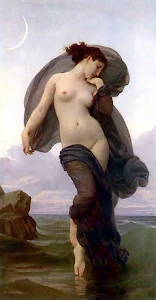L'Amour Et Psyché, Enfants
L'Amour et Psyché, enfants is an oil painting by William Adolphe Bouguereau in 1890. It is currently in a private collection. It was displayed in the Salon of Paris in 1890, the year Bouguereau was President of the Société des Artistes Français. The painting features Greek mythological figures Eros and Psyché, sharing an embrace and kiss. Bouguereau was a Classical-style painter in the Neoclassical era of art. The painting is characterized by the frothy background the figures delicately stand on. It depicts the beginning of the forbidden romance of Cupid and Psyche, a popular subject at the time of execution.
The resurgence of interest in Classical Greek and Roman mythology of the mid-eighteenth century gave way for the renderings to the story of Cupid and Psyche. The daughter of a King and Queen, Psyche was born with beauty that led to men worshipping her. This angered Venus, Cupid's mother and Goddess of Beauty. She sent Cupid to prick her with his arrow, forcing her to fall in love with a hideous creature as revenge. Instead, Cupid scratches himself with his own arrow and falls in love with Psyche. He marries her in secrecy on the condition that she may never see his face. He flees when her curiosity gets the better of her. Psyche roams the earth and underworld in search of her lover. They eventually reunite and she is granted the gift of immortality. Their triumph over adversity from Venus and their differences in mortality makes this theme popular.
William Bouguereau chooses to portray the characters of Cupid and Psyche as young children, almost babies. Cupid, the Roman interpretation of Eros, is often portrayed as a fantastic, mischievous winged baby with a bow and arrow. Eros, the Greek equivalent, is often depicted as a young man, which is when the love affair between him and Psyche plays out. Instead, we see Cupid as a baby, Psyche is also portrayed as a young child, though typically through art history she is seen as a young woman. Bouguereau chooses to paint her with butterfly wings, for psyche was the Greek word given to butterflies by Aristotle. Psyche is a symbol to the transformation of the human soul, as she transforms from human to immortal. The decision to paint the characters as children is a reference to their innocence, before the corruption of their affair by Venus. This depiction would have been widely accepted in the Salon it was shown at. Bouguereau applied this story in multiple paintings of his depicting them as the young lovers we are more familiar with.
Source and Courtesy : https://en.wikipedia.org/wiki/L%27Amour_et_Psych%C3%A9,_enfants
Bouguereau fell into disrepute after 1920, due in part to changing tastes. Comparing his work to that of his Realist and Impressionist contemporaries, Kenneth Clark faulted Bouguereau's painting for "lubricity", and characterized such Salon art as superficial, employing the "convention of smoothed-out form and waxen surface."






















